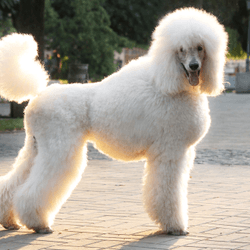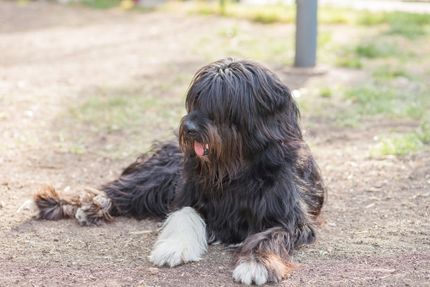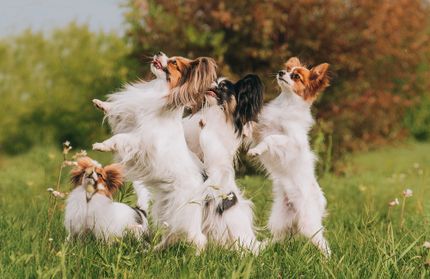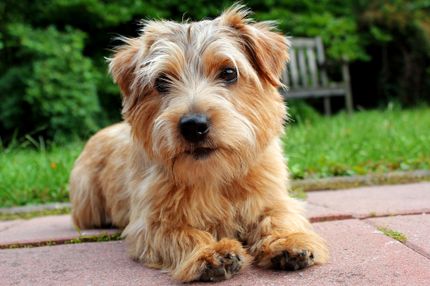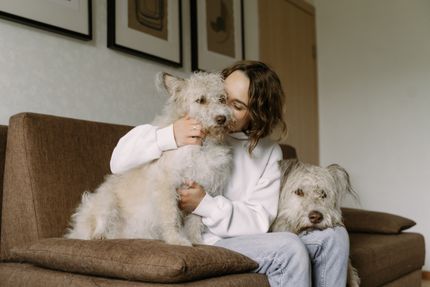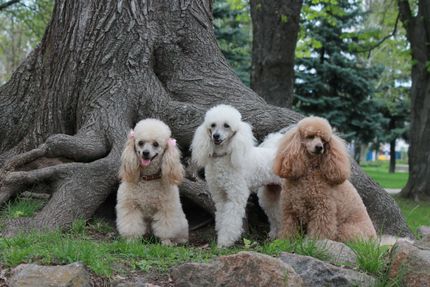Saint Berdoodle:Saint Bernard and Poodle Mix
Facts & Origin
St. Bernard and Poodle Mix - a hybrid breed.
The St. Bernard and Poodle mix is a large, friendly dog that gets along well with family. They are intelligent and easy to train, making them a perfect choice for those looking for a loyal companion.
What are breed characteristics of this mix dog?
The Saint Bernard Poodle mix breed is a large dog with a weight of 50-70 kg. They have a strong and muscular body and a dense coat that can be either black, brown or white. Their body measurements are as follows: Shoulder height of 60-70 cm, chest circumference of 80-90 cm and a waist circumference of 70-80 cm.
| Alternate Name | - |
| Origin | Switzerland - Germany |
| Life expectancy | 8 - 15 years |
| Care requirements | high-maintenance |
| Activity level | average - high |
| FCI group | not recognised |
| AKC group | not recognised |
| KC group | not recognised |
More Saint Bernard mixes
More Poodle mixes
Attitude, character and temperament of the breed
Possible character traits of St. Bernard and Poodle mix - So is probably his nature.
Most people think of a St. Bernard as a large, shaggy dog with a noticeably long muzzle. However, the St. Bernard is actually a mix of a St. Bernard and a Poodle. The St. Bernard is known for its loyalty, while the Poodle is known for its intelligence. This blend of two popular breeds makes for a loyal, intelligent dog that can also be a good watchdog.
The St. Bernard is a large dog, usually weighing between well over 50 kg. The coat of the St. Bernard is thick and dense, making it well suited for cold climates. The coat is usually red or tan with white markings on the chest and toes.
The Poodle is a smaller breed, usually weighing between 5-15 kg. They are an active breed known for their intelligence and obedience. Poodles come in a variety of colors including black, white, brown and cream. They also have a variety of coat types, including curly, wavy and smooth.
The Saint Bernard Poodle mix is a relatively new breed, and therefore there is no real standard for their appearance. However, they usually resemble their St. Bernard parent more than their Poodle parent in terms of size and coat type. They usually have a dense, red or tan coat with white markings on the chest and toes.
St. Bernard-Poodle mixes are still quite rare, but are becoming more popular as people learn about the great qualities of this breed.
Character
Usage


Health and breeding information
What diseases can occur in St. Bernard and poodle mix.
While owning a St. Bernard and Poodle mix has many wonderful aspects, there are also some health issues to be aware of. Here are some of the most common health problems that occur with this breed:
One of the most common problems in Saint Bernard Poodle mixes is hip dysplasia. This is a condition in which the hip joint is not properly formed, resulting in pain and lameness. It is common in large breeds and may be genetic.
Another problem that is common in Saint Bernard Poodles is allergies. They can be allergic to foods, pollen and other environmental allergens. If your dog scratches a lot, his eyes water, or he has hair loss, it may be due to an allergy.
Saint Bernard poodles are also prone to flatulence. This is a condition where the stomach turns over on itself and the blood supply can be cut off. This is a medical emergency and can be fatal if not treated immediately. Signs of bloating include a distended abdomen, restlessness and rapid heartbeat.
Saint Berdoodles can also suffer from congenital heart defects, epilepsy and hypothyroidism, although this is not as common.
What does this mixed breed look like?
The St. Bernard-Poodle mix has a long and dense coat. Most of the coat is white, although there may be some light brown or black markings on the face and ears. The coat needs to be combed and brushed regularly to keep it looking its best.
| Fur length | medium |
| Fur | flat coated - curly |
| Ear shape | Floppy Ear |
| Tail | fanned out - lang |
| Anatomy | strong, slim, sporty |
| Size ♀ | 45 - 80 cm |
| Weight ♀ | 18 - 120 kg |
| Size ♂ | 45 - 90 cm |
| Weight ♂ | 18 - 120 kg |
| Suitable For | - |
Known Diseases
Epilepsy
Definition: Dog has epilepsy if, for example, at least two epileptic seizures occur more than 24 hours apart.
Cancer
May be common in older dogs.
Skeletal disorders
IPA, FPC and OCD occur in dogs at four to five months of age during the most severe growth spurt.
Eye diseases
Often occur with allergies and intolerances.
Cataract
Cataracts are still one of the most common causes of blindness, even in dogs.
Patellar problems
Problems with the Patellar can be a displacement or weak kneecap, which is one of the most common causes of lameness in dogs, also because of overweight.
Progressive Retinal Atrophy (PRA)
Progressive retinal atrophy (PRA) is a slowly progressive death of the retina in dogs.
FAQ
-
A St. Bernard-Poodle mix is a hybrid dog breed created by crossing a St. Bernard with a Poodle. These dogs are usually large and have a thick, fluffy coat. They are often used as working dogs and are known for their loyalty and affectionate nature.
-
St. Bernard and Poodle mixes usually weigh between 50-70 kg. They have a strong and muscular body and a dense coat that can be either black, brown or white. Their body measurements are as follows: Shoulder height from 60-70 cm.
-
The average life expectancy of a St. Bernard-Poodle mix is 10-12 years.
-
Saint Bernard and Poodle mixes are usually good with children and other pets. They are known to be loyal, affectionate and intelligent dogs.
-
Common health problems in St. Bernard and Poodle mixes include hip and elbow dysplasia, eye problems, and flatulence.
Useful Articles
You can find articles that might interest you in the dogbible blog to match your favorite breed.
Visit our magazineto stay up to date on dog trends.
To find out more, view our Privacy Policy
Find here the breed that suits you and find out what character traits it has. Here you can also learn more about the origin, size and weight of your favorite breeds.
Matching your favorite breed, you'll find articles that might interest you on the dogbible dog blog.
Dog licence: Baden-Württemberg introduces compulsory dog licence
Hiking with dog in Saxon Switzerland
Keep your eyes open when buying a puppy

